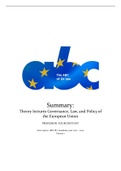Resume
Summary Governance Law and Policy of the European Union Theory Lectures ('21 - '22)
- Établissement
- Vrije Universiteit Brussel (VUB)
Comprehensive summary of the lectures for the course Governance Law and Policy of the European Union. Suitable for students International Business. Given by Youri Devuyst at the Vrije Universiteit Brussel in the academic year .
[Montrer plus]












